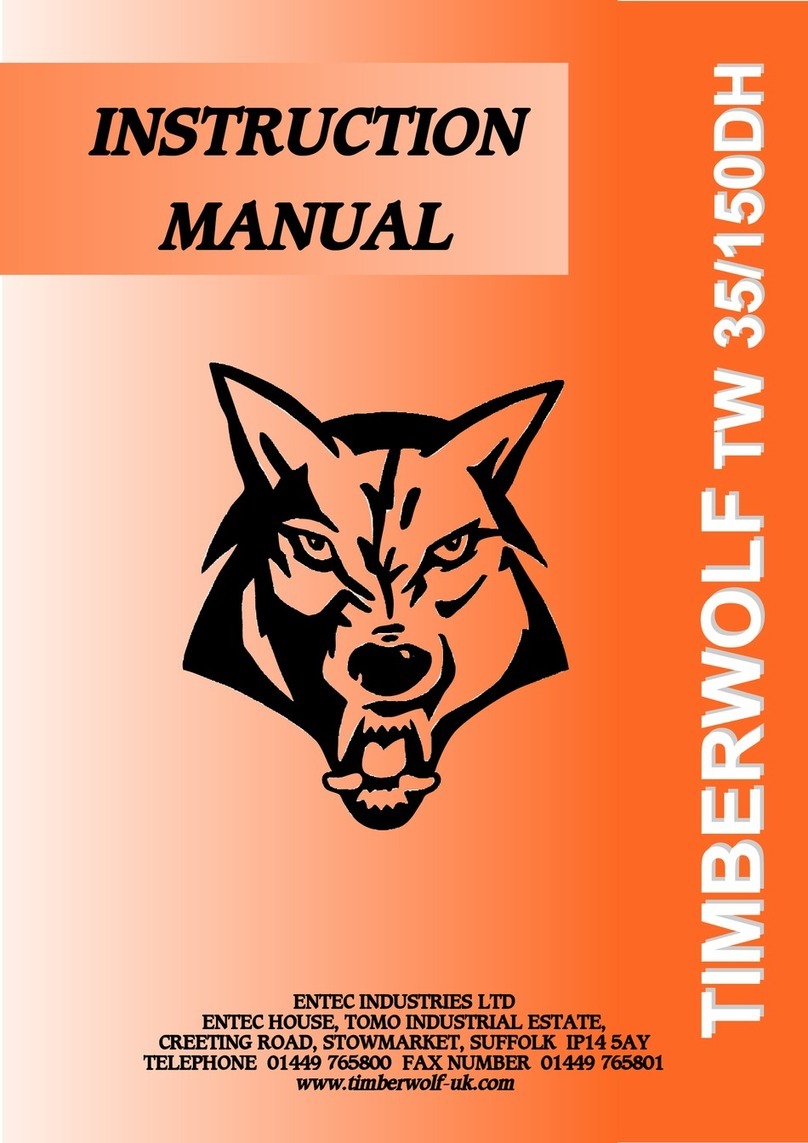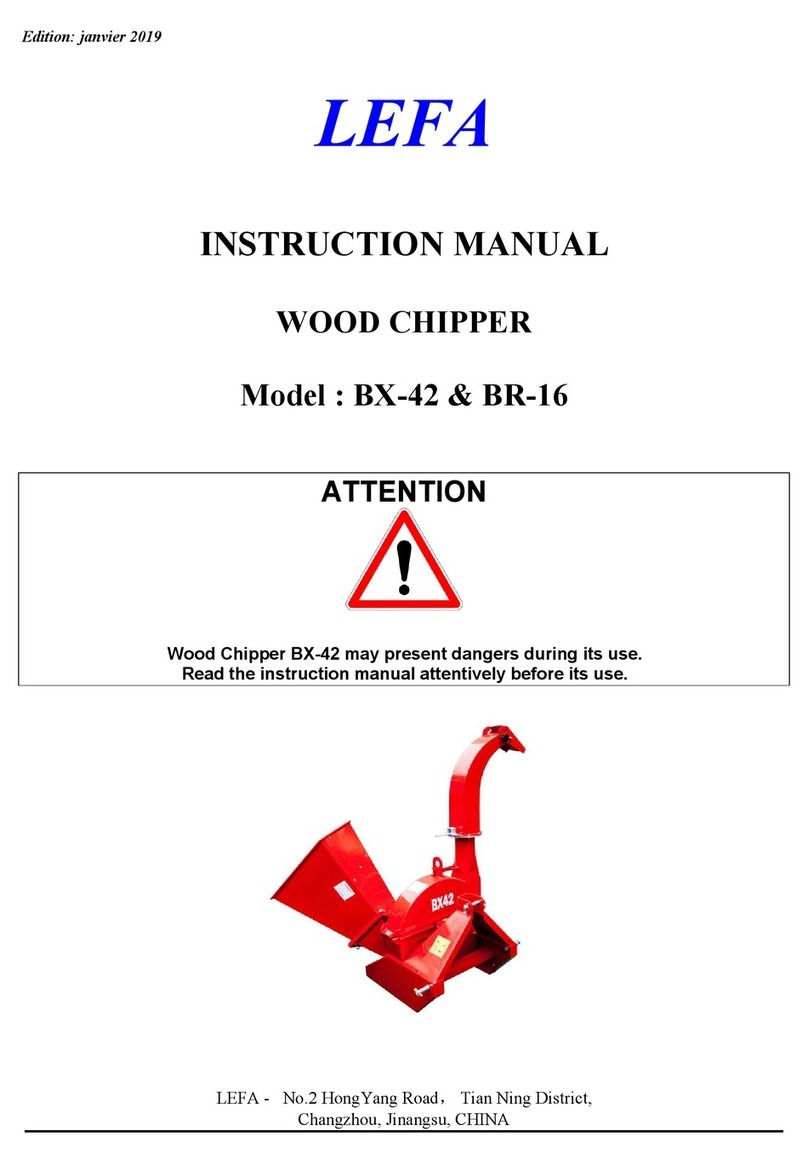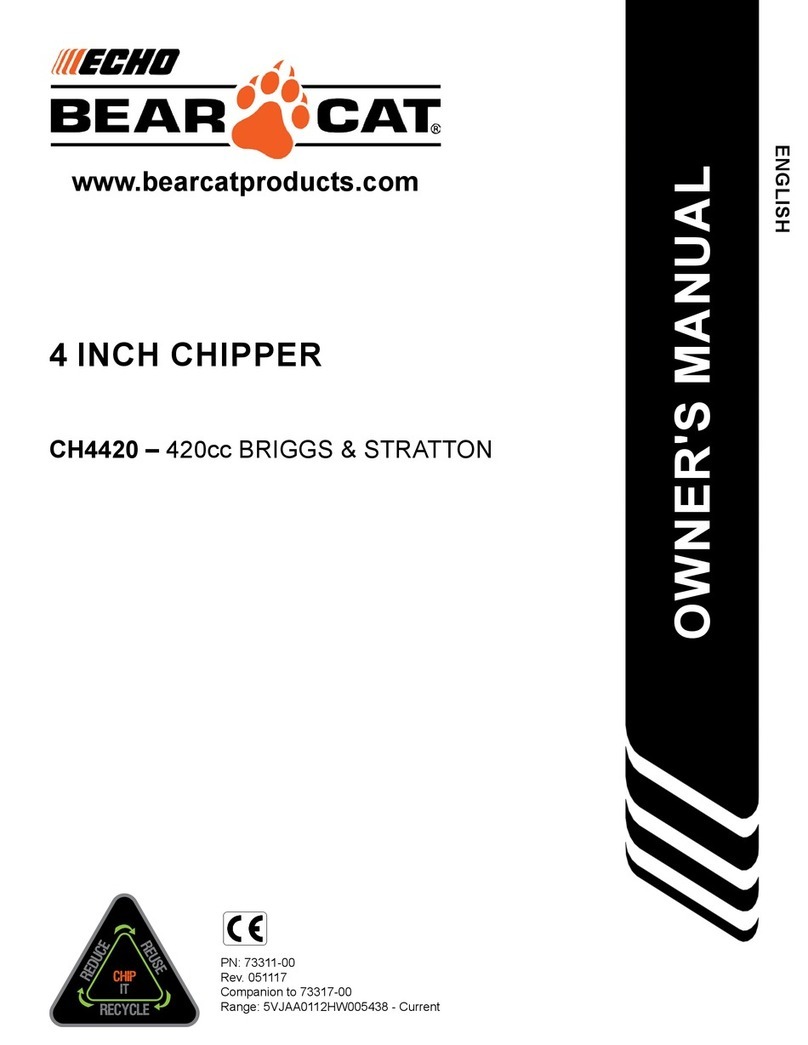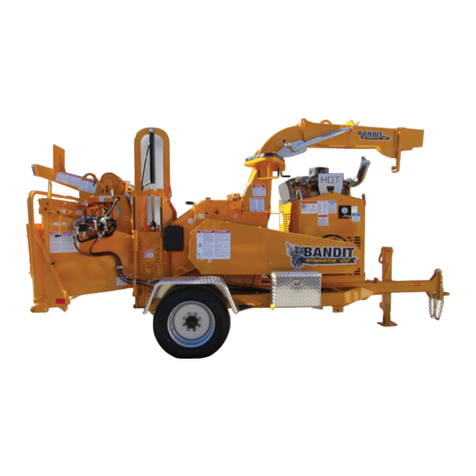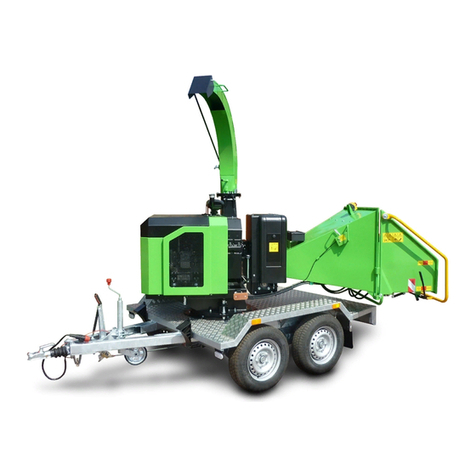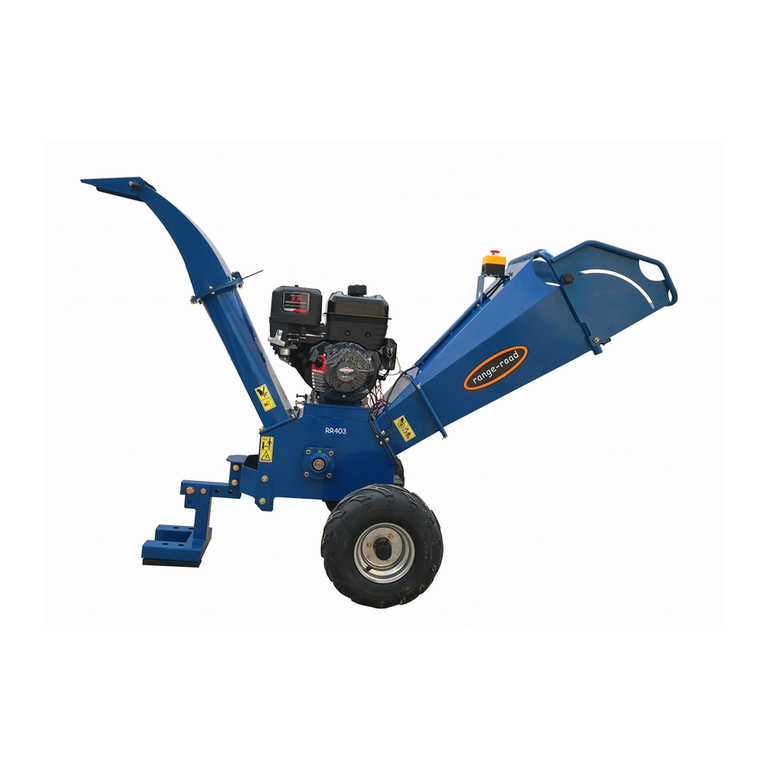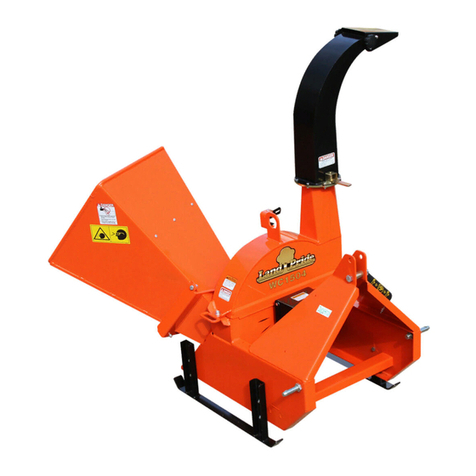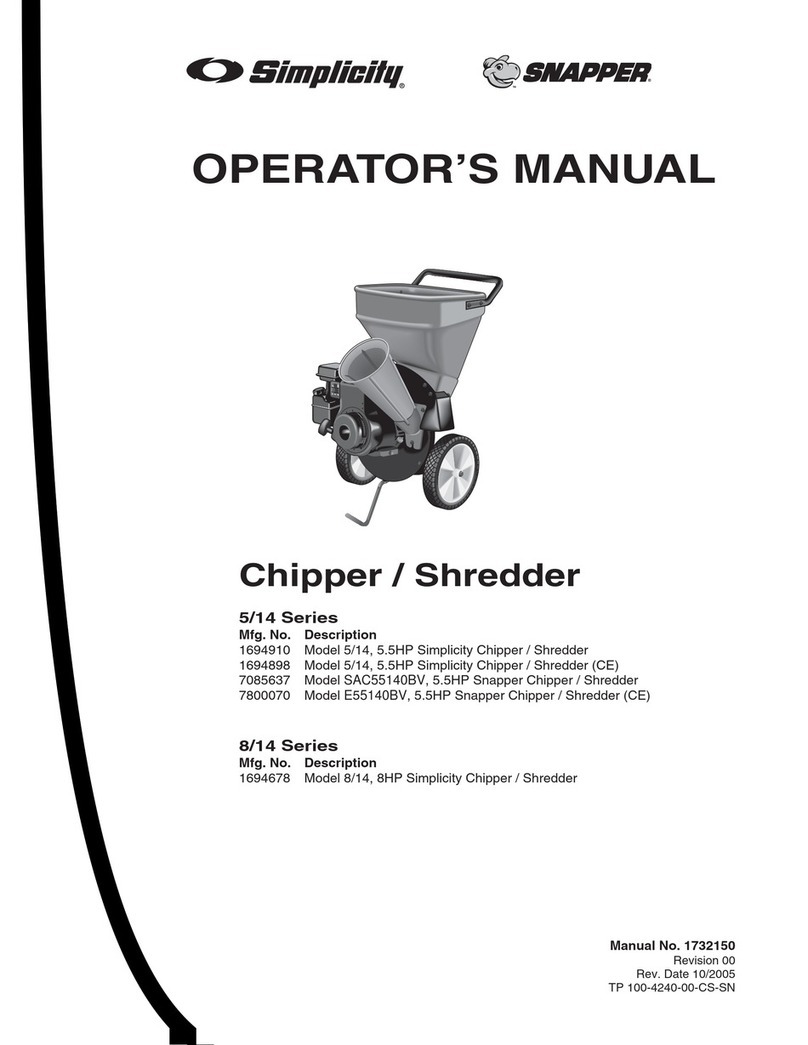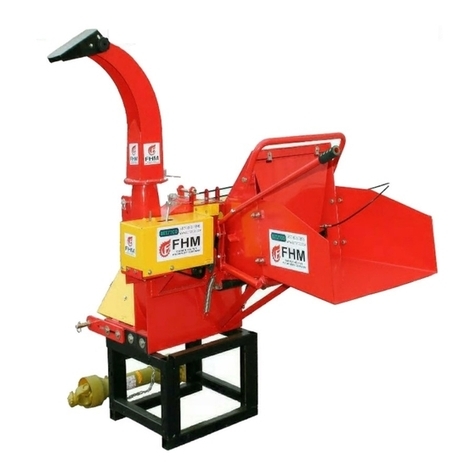Entec TIMBERWOLF PTO 300H User manual

TIMBER
TIMBERWOLF PT
WOLF PTO 300H
O 300H
IINNSSTTRRUUCCTTIIOONN
MMAANNUUAALL
EENNTTEECC
IINNDDUUSSTTRRIIEESS
EENNTTEECC
HHOOUUSSEE,,
TTOOMMOO
IINNDDUUSSTTRRIIAALL
EESSTTAATTEE,,
CCRREEEETTIINNGG
RROOAADD,,
SSTTOOWWMMAARRKKEETT,,
SSUUFFFFOOLLKK
IIPP1144
55AAYY
TTEELLEEPPHHOONNEE
0011444499
776655880000
FFAAXX
NNUUMMBBEERR
0011444499
776655880011
wwwwww..ttiimmbbeerrwwoollff-uukk..ccoomm

CONTENTS
Section Page No.
INTRODUCTION 1
PURPOSE OF MACHINE 2
MACHINE DIMENSIONS 2
PARTS LOCATION DIAGRAMS 3 & 4
SAFE WORKING 5
Operator’s Personal Protective Equipment Required 5
Basic Woodchipping Safety 5
General Safety Matters - Do’s and Dont’s 6
Noise Test 7
OPERATING INSTRUCTIONS 8
Connecting to Tractor 8
Before Starting Tractor 8
Before Using the Chipper 8
Moving the Chipper 8
Delivery 9
Operator’s Personal Protective Equipment Required 9
Daily Checks before Starting 9
PTO Shaft 9
Manual Controls 10
Auto Controls 10
Emergency Stopping 10
Discharge Controls 11
Hydraulic Oil Thermometer 12
Hydraulic Oil Lever Indicator 12
Starting the Chipper 12
Chipping 12
Stopping the Chipper 13
Blockages 13
Fitting the Discharge Tube 14
SERVICE INSTRUCTIONS 15
Service Schedule 15
Safe Maintenance 16
Spares 16
Grease the Roller Box 16
Grease the Roller Box Slides 16
Change Blades 17
PTO Drive Shaft Maintenance 18
Check Fittings 18
Grease the Roller Drive Splines 18
Tension Hydraulic Pump Belt 18
Check Hoses 19
Change Hydraulic Oil and Filter 19
Change Anvil 19
Service to the Safety Bar 20
Sharpen the Roller Blades 20
WARRANTY STATEMENT 21
EC DECLARATION OF CONFORMITY CERTIFICATE 22
STICKERS 23 & 24
WIRING DIAGRAM 25
CIRCUIT DIAGRAM 26
HYDRAULIC LAYOUT 27
PARTS LISTS 28 - 41
AMENDMENTS 42 - 47
ISSUE 14

TIMBERWOLF PTO 300H
Thank you for choosing this Entec/Timberwolf brushwood chipper. Entec/Timberwolf
chippers are designed to give safe and dependable service if operated according to the
instructions.
Before using your new chipper, please take time to
read this manual which contains
IMPORTANT HEALTH AND SAFETY INFORMATION
and explains the chipper controls - failure to do so could result in :
- personal injury
- equipment damage
- damage to property
- a member of the general public becoming injured
This manual covers the operation and maintenance of the Timberwolf 300H. All
information in this manual is based on the latest product information available at the
time.
NOTE -Also supplied with this manual. 1 x Prop shaft instruction sheet.
All the information you need to operate the machine safely and effectively is contained
within pages 2 to 12. Ensure that all operators are adequately trained for operating
this machine especially with regard to safe working practices.
Entec's policy of constantly improving their products may involve major or minor
changes to the chippers or their accessories. Entec Industries reserves the right to
make changes at any time without notice and without incurring any obligation.
Due to improvements in design and performance during production, in some cases
there may be minor discrepancies between the actual chipper and the text in this
manual.
The manual should be considered a permanent part of the
machine and should remain with it if the machine is resold.
!CAUTION or WARNING
Be aware of this symbol and where shown
carefully follow the instructions
This caution symbol indicates important safety messages in this manual. When
you see this symbol be alert to the possibility of injury to yourself or others, and
carefully read the message that follows.
Always follow safe operating and maintenance practices
INTRODUCTION
1

TIMBERWOLF PTO 300H
PURPOSE OF MACHINE
2
Serial No Location
The serial number can be found on the
metal plate riveted to the vertical brace
plate behind the left hand lower three point
pin. Do not remove/deface this plate -
these numbers must be quoted in any
correspondence with Entec Industries.
Chipper Weight complete
without prop. shaft
1250 KILOS
The Timberwolf 300H brushwood chipper is designed to chip solid wood
material up to 300mm in diameter, depending on tractor horsepower. It is
capable of chipping over five tonnes of brushwood per hour.
1696mm
SPECIFICATIONS
2800 mm
2595 mm (1956 mm with feed table folded)
1525mm
690 mm

PARTS LOCATOR 3
DISCHARGE
BUCKET
DISCHARGE
TUBE
OPENING
ROTOR
HOUSING
SAFETY BAR
CONTROL BOX
TOP
GUARD
GAS
SPRING
MOTOR SIDE
GUARD
FEED TRAY
FUNNEL
OPEN SIDE GUARD
ROTOR
FRAME
BELT GUARD
3 POINT
LINKAGE
ELECTRIC
VALVE
CATCH
SLIDE
fig 1.
ROLLER BOX COVERS
DISCHARGE
CLAMP
BOLT
1
4
2
3

PARTS LOCATOR 4
FLOW DIVIDER
PTO CONNECTOR
PUMP BELTS
HYDRAULIC PUMP
OIL LEVEL GAUGE
TANK TOP FILTER
HYDRAULIC MOTORS
TOP BAR ASSEMBLY
HYDRAULIC OIL TANK
SUMP PLUG
fig 2.
ROLLER BOX

SAFE WORKING
OPERATOR'S PERSONAL PROTECTIVE EQUIPMENT REQUIRED
Chainsaw safety helmet fitted
with visor and recommended
ear defenders to the
appropriate specifications
Loose fit,
Heavy-duty gloves.
Close fitting heavy-duty
non-snag clothing
Face mask if
appropriate.
DO NOT
wear rings, bracelets,
watches, jewellery or any
other items that could be
caught in the material and
draw you into the chipper.
BASIC WOODCHIPPING SAFETY
The operator should be aware of the following points:
MAINTAIN A SAFETY EXCLUSION ZONE around the chipper of at least 10 metres for the
general public or employees without adequate protection. - Use hazard tape to identify this
working area and keep it clear from debris build up. Chips should be ejected away from any
area the general public have access to.
HAZARDOUS MATERIAL - Some species of trees and bushes are poisonous. The chipping
action can produce vapour, spray and dust that can irritate the skin. This may lead to
respiratory problems or even cause serious poisoning. Check the material to be chipped before
you start. Avoid confined spaces and use a facemask if necessary.
BE AWARE when the chipper is processing material that is an awkward shape. The material
can move from side to side in the funnel with great force. If the material extends beyond the
funnel the brash may push you to one side causing danger. Badly twisted brash should be
trimmed before being chipped to avoid thrashing in the feed funnel.
BE AWARE that the chipper can eject chips out of the feed funnel with considerable force.
Always wear full head and face protection.
ALWAYS work on the side of the machine furthest from any local danger, e.g not road side.
WARNING
The Timberwolf PTO will feed material through on its own. To do this, it relies on
sharp blades on the chipper rotor. To keep the blades sharp, only feed
the machine with clean brushwood.
DO NOT put muddy / dirty wood, roots, potted plants, bricks,
stones or metal into the chipper.
!
!
Safety Boots
5

SAFE WORKING 6
DO’S AND DONT’S
GENERAL SAFETY MATTERS
DO NOT use chipper unless available light is
sufficient to see clearly.
DO NOT use or attempt to start the chipper
without the feed funnel, belt guard, guards and
discharge unit securely in place.
DO NOT start the chipper running unless properly
guarded.
DO NOT stand directly in front of the feed funnel
when using the chipper. Stand to one side.
DO NOT allow -
DO NOT smoke when refuelling.
Petrol is explosive!
DO NOT let anyone who has not received
instruction operate the machine.
DO NOT climb on the machine at any time.
DO NOT handle material that is partially engaged
in the machine.
DO NOT touch any exposed wiring whilst
machine is running.
- to enter the machine, as damage is likely.
BRICKS STRING CLOTH PLASTIC STONES
METAL GLASS RUBBER ROOTS BEDDING
PLANTS
ALWAYS stop the chipper engine before making
any adjustments, refuelling, or cleaning.
ALWAYS check machine has stopped rotating
and remove chipper ignition key before
maintenance of any kind, or whenever the
machine is to be left unattended.
ALWAYS check machine is well supported and
cannot move.
ALWAYS run with the engine set to maximum
speed.
ALWAYS check (visually) for fluid leaks.
ALWAYS take regular breaks. Wearing personal
protective equipment for long periods can be
tiring and hot.
ALWAYS keep hands, feet and clothing out of
feed opening, discharge and moving parts.
ALWAYS use the next piece of material or a push
stick to push in short pieces. Under no
circumstances should you reach into the funnel.
ALWAYS keep the operating area clear of people,
animals and children.
ALWAYS keep the operating area clear from
debris build up.
ALWAYS keep clear of the chip discharge tube.
Foreign objects may be ejected with great force.
ALWAYS ensure protective guarding is in place
before commencing work. Failure to do so may
result in personal injury or loss of life.
ALWAYS use chipper in a well ventilated area -
exhaust fumes are dangerous.
!

SAFE WORKING
MACHINE:
NOTES:
TIMBERWOLF PTO 300H ATTACHED TO A JCB
FASTRAK
TESTED CHIPPING 4 INCH ROUND POLES
ALL READINGS REPRESENT TRACTOR WITH
CHIPPER CHIPPING
113.3 dB
105.8 dB
1 METRE
101.8 dB 98.2 dB
90.4 dB
R= 4 metres
Noise levels between 90 and 113.3dBA will be experienced at the working position. Wear ear
defenders at all times to prevent possible damage to hearing. All persons within a 4 metre
radius must also wear ear defenders.
NOISE TEST
fig 3.
7

OPERATING INSTRUCTIONS
BEFORE STARTING TRACTOR
BEFORE USING THE CHIPPER
ENSURE feed funnel, feed roller guard, prop shaft guards and access covers are fitted and secure, and that
discharge unit is fitted and pointing in a safe direction.
WHEN ready to start chipping, increase PTO speed slowly until 1000 rpm. is achieved.
IT IS ESSENTIAL TO CARRY OUT THE FOLLOWING TESTS to check safety equipment - this
sequence of tests will only take a few seconds to carry out. We recommend that these tests are
carried out daily. Observing the function as described will confirm that the safety circuits are
working correctly. This is also a good opportunity to remind all operators of the control and
emergency stop systems.
DO NOT move the chipper with the rotor running.
ALWAYS ensure the discharge transport pin is in place before moving.
MOVING THE CHIPPER
CONNECTING TO TRACTOR
WARNING
Ensure the tractor is turned off and the ignition key removed before
connecting the PTO. PTO shafts are the major cause of
incidents on agricultural machinery.
4
7
568
23
PRESS THE GREEN
BUTTON
THE ROLLERS
SHOULD RUN
PRESS THE RED BAR
THE ROLLERS SHOULD
STOP
PRESS THE BLUE BUTTON
THE ROLLERS SHOULD TURN
BACKWARDS ONLY WHILE THE
BUTTON IS PRESSED
PRESS THE GREEN
BUTTON AGAIN
THE ROLLERS SHOULD
RUN
PRESS THE EMERGENCY
RED BUTTON
THE ROLLERS SHOULD
STOP
PRESS THE BLUE
BUTTON
THE ROLLERS
SHOULD NOT TURN
TWIST TO RESET
THE RED BUTTON
THE MACHINE IS READY
TO USE
ENSURE drive shaft ends are securely fitted to PTO shaft and implement input shaft.
CHECK for properly guarded PTO shaft, implement input and drive shaft.
CHECK that guard chains are securely attached to stationary frame to prevent rotation of guard.
CONNECT power cable from tractor to chipper.
LOCATE the machine on firm level ground.
CHECK the discharge unit is in place and fastened securely.
CHECK discharge tube is pointing in a safe direction.
CHECK the feed funnel to ensure no objects are inside.
CHECK feed table is in up position - to prevent people reaching rollers.
CHECK controls as described on page10.
For parts location see TIMBERWOLF 300H diagrams on pages 3 & 4
1
PRESS THE RED
BAR TO POWER
THE CONTROL
SYSTEM
8
WITH THE ROTOR RUNNING AT 1000 RPM
!
!

OPERATING INSTRUCTIONS
DELIVERY
All Timberwolf 300H PTO machines have a full pre delivery inspection before leaving the factory and
are ready to use. Read and understand this instruction manual before attempting to operate the
Chipper. In particular, read pages 5-8 which contains important health and safety information and
advice.
OPERATOR’S PERSONAL PROTECTIVE EQUIPMENT REQUIRED
CHAINSAW safety helmet fitted with visor and recommended ear defenders to an
appropriate specification.
HEAVY-DUTY gloves.
CLOSE - FITTING heavy-duty non-snag clothing.
SAFETY footwear.
FACE MASK (if appropriate).
See page 5 for more detailed information.
DAILY CHECKS BEFORE STARTING
ENSURE drive shaft ends are securely fitted to PTO shaft and implement input shaft.
CHECK for properly guarded PTO shaft, implement input and drive shaft.
CHECK that guard chains are securely attached to stationary frame to prevent rotation of guard.
CONNECT charging cable from tractor to chipper (if available).
LOCATE the machine on firm level ground.
CHECK the discharge unit is in place and fastened securely.
CHECK discharge tube is pointing in a safe direction.
CHECK the feed funnel to ensure no objects are inside.
CHECK feed table is in up position - to prevent people reaching rollers.
CHECK controls as described on page10.
For parts location see diagrams on page 3 & 4.
CHECK the angle of the prop shaft when connected to the tractor, which should not exceed 16o.
CHECK that when the machine is lifted for transport the prop shaft does not reach an angle that
causes damage.
IF the prop shaft is supplied with a torque limiter or clutch, this must be fitted to the chipper end of
the drive shaft.
PTO SHAFT
9

OPERATING INSTRUCTIONS
Roller control box - is the control box above the feed opening of the chipper funnel. Its function is to control
the feed rollers. The feed rollers draw material into the machine. It does not control the main rotor.
RED SAFETY BAR = This is the large red bar that surrounds the feed table and side of the feed
funnel. The bar is spring loaded and connected to a switch that will interrupt the power to the rollers.
The switch is designed so that it only activates if the bar is pushed to the limit of its travel. The rollers
stop instantly, but can be made to turn again by pressing either the GREEN FEED or BLUE REVERSE
control buttons.
RED SAFETY BAR TEST.
To ensure the safety bar is always operational it must be activated once before each work session.
The rollers will not function until the bar is activated. This procedure must be repeated each time
the ignition is switched off.
GREEN BUTTON = forward feed - Push the button once - this activates the rollers and will allow you
to start chipping (if the rotor speed is high enough).
RED BUTTON = stop feed / emergency stop - This button stops the rollers from feeding. It overrides
all other buttons or bars and will not allow the other buttons to function until it has been reset.
To reset, twist until it returns to its original position. The forward and reverse buttons will now function.
BLUE BUTTON = reverse feed - allows you to back material out of the rollers. The rollers will only
turn in reverse as long as you keep pressing the button. You do not have to press the STOP button
before pressing the GREEN FEED button to recommence feeding.
MANUAL CONTROLS
AUTO CONTROLS
The no stress unit controls the feed rate of the material going into the chipping chamber. If the rotor
speed is below the predetermined level the No Stress Unit will not allow the feed rollers to work in
either forward or reverse until the rotor speed rises above the predetermined level, at which point the
feed rollers will start turning without warning.
Do not rely on the red bar to keep the rollers stationary if it
is necessary to clear or touch the rollers. Always switch off
the machine before approaching the rollers.
GREEN FORWARD
FEED BUTTON
BLUE REVERSE
FEED BUTTON
RED STOP FEED -
EMERGENCY STOP
BUTTON
RED SAFETY BAR
Control Panel Diagram
Push the RED STOP button or push the RED CONTROL BAR
(whichever is the quickest for you to reach).
Turn off tractor ignition key or operate tractor stop lever.
The emergency stop will prevent any more material being fed into the chipper. The rotor will still be
turning. The tractor must be disengaged or powered down to stop the rotor.
EMERGENCY STOPPING
fig 4.
10

OPERATING INSTRUCTIONS 11
DISCHARGE CONTROLS
As the wood is chipped the chips will exit the machine via the discharge tube. The discharge tube
may be adjusted so that the chips fall in a convenient and safe place. Small adjustments are possible
with little effort.
To aid the adjustment of the discharge tube a 3 in 1 tool is provided. It is designed to do all the
adjustments required using the correct amount of force. It is attached to the discharge flange on a
length of cord.
ITS THREE FUNCTIONS ARE (FIG 5);
i) A transport pin ii) Clamping the bucket adjustment iii) Adjusting the turning friction
i
iii
ii
THE DISCHARGE CONTROLS ARE (FIGS 5&6);
1. Transport position 2. Bucket Attitude 3. Tube rotation 4. Friction setting
TRANSPORT POSITION - As the discharge tube is used without a rotational clamp it is necessary
to fix its position when being transported.
WARNING
Failure to secure the discharge during transport can result in serious damage to
the machine and its surroundings.
With the discharge pointing in the direction shown two holes line up and the tool may be dropped into
position (fig. 5, i).
BUCKET ATTITUDE - Using the tool the 19mm nut may be loosened and the control handle moved
to a suitable position (fig. 5, ii).
TUBE ROTATION -
- Remove the tool from the transport position (fig. 5, i).
- Unclip the tubular turning handle from underneath the discharge tube (fig. 6).
- Push or pull the turning handle to a suitable position.
- Clip the turning handle back into position.
FRICTION SETTING - Whilst rotating the discharge tube it may be found that the effort required is
either too much or too little. Too little effort and the discharge tube may rotate without warning. Too
much effort and small adjustments will be difficult. A 17mm screw underneath the discharge flange
can be wound in or out to adjust the friction overall. This can be adjusted to suit the operator or
working environment (fig. 5, iii).
fig 5. fig 6.
!!

OPERATING INSTRUCTIONS
CHIPPING
Wood up to 300mm diameter can be fed into the feed funnel. Put the butt end in first and engage it
with the feed roller. The hydraulic feed rollers will pull the branch into the machine quite quickly. Large
diameter material will have its feed rate automatically controlled depending on the tractor power
available.
Sometimes a piece of wood that is a particularly awkward shape is too strong for the feed rollers to
break. This will cause the top roller to either bounce up and down on the wood or both rollers to stall.
If this occurs press the BLUE REVERSE button until the material has been released. Pull the material
out of the feed funnel and trim it so the chipper can handle it.
Both feed rollers should always turn at the same speed. If one or both rollers stop or suddenly slow
down it may be that a piece of wood has become stuck behind one of the rollers. If this occurs press
the BLUE REVERSE button and hold for 2 seconds - then repress GREEN FEED button. This should
enable the rollers to free the offending piece of material and continue rotating at the correct speed. If
the rollers continue to stall in the 'forward feed' or 'reverse feed' position push the RED STOP
BUTTON, turn tractor engine off, remove ignition key and investigate.
STARTING THE CHIPPER
WARNING
Do not use or attempt to start the chipper without the
protective guarding and discharge unit securely in place.
Failure to do so may result in personal injury or loss of life.
!!
CONNECT the tractor power cable.
START tractor and set revs to 1500 rpm.
GENTLY engage PTO clutch.
INCREASE tractor revs until tractor PTO speed = 1000 rpm.
DO NOT RUN ON ANY OTHER PTO SPEED SETTING.
CHECK that chipper is running smoothly.
RELEASE the catch on the feed table and lower. Turn to release the red stop button.
PRESS the green control button. The rollers will commence turning.
STAND to one side of the feed funnel.
PROCEED to feed material into the feed funnel.
12
This is situated on the side of the hydraulic oil tank. When the chipper is
running the oil temperature should not exceed 65oC. If it does, stop the
machine immediately. Failure to do so may result in damage. Overheating can
result from the chipper being worked extremely hard in hot conditions, as the
oil is not getting a chance to cool down. Stop the chipper and allow oil to cool
before continuing. If the temperature goes above 65oC and the machine is not
being worked hard or the air temperature is not particularly high this indicates low
oil, a jammed hydraulic motor or valve. Stop immediately and investigate.
When the chipper is on level ground the oil level should sit between the red
line at the bottom of the gauge and the blue line at the top. If this level drops
significantly it indicates an oil leak. Stop immediately and investigate.
HYDRAULIC OIL THERMOMETER / OIL LEVEL INDICATOR
fig 7.

OPERATING INSTRUCTIONS
PUSH the RED STOP button (see Control Panel fig. 4, page 10).
SHUT feed funnel.
KEEPING PTO engaged set tractor speed to idle.
WHEN idle speed steady stop tractor engine.
WHEN engine stationary disengage PTO clutch.
DO NOT disengage the PTO clutch while engine is running as the chipper cutting disc may
continue to free wheel for a long time.
BLOCKAGES
Always be aware that what you are putting into the chipper must come out. If the chips stop coming
out of the discharge tube but the chipper is taking material in - STOP IMMEDIATELY. Continuing to
feed material into a blocked machine may cause damage and will make it difficult to clear.
If the chipper becomes blocked proceed as follows:
STOP the tractor engine and remove the ignition keys. Ensure rotor has stopped turning by
observation of the drive shaft.
REMOVE the two opening rotor housing bolts and use the handle to raise the housing.
The chips causing the blockage should fall clear. It is not necessary to remove all the chips.
Some will remain lying in the bottom of the rotor housing, which the chipper will eject when it
is restarted.
WARNING
Do not reach into the rotor housing with unprotected hands. There are
sharp blades and any small movement of the rotor may cause serious injury.
CLOSE the housing and re install the bolts.
RESTART tractor, engage the PTO and run at working speed.
ALLOW machine time to clear excess chips still remaining in rotor housing before you
continue feeding brushwood. Feed in a small piece of wood whilst watching to make sure
that it comes out of the discharge. If this does not clear it, repeat the process and carefully
inspect the discharge tube to find any obstruction.
NOTE
Continuing to feed the chipper with brushwood once it has become blocked will cause the chipper to
compact the chips in the rotor housing and it will be difficult and time consuming to clear.
AVOID THIS SITUATION - WATCH THE DISCHARGE TUBE AT ALL TIMES.
STOPPING THE CHIPPER
!!
13

OPERATING INSTRUCTIONS 14
FITTING THE DISCHARGE TUBE
The discharge tube will need to be removed and refitted from time to time, when storing indoors for
example, or driving under low bridges. This procedure should only be undertaken as follows.
WARNING
The Discharge Tube weighs 60 kilos and failure to follow
the correct procedure could result in injury. !
!
1. Using 2 x 24mm spanners remove the Rotor Housing Bolts (see fig 12. on page 17).
2. Lift the Rotor Housing until the catch engages.
3. Remove the top section of the Discharge Bearing.
4. Lift the Discharge Tube and position so that it faces the tractor.
5. Place the Discharge Tube flange (a) into the slot on the bottom section of the Discharge Bearing (b).
6. Install the top section of the Discharge Bearing ensuring the plastic disc is in place.
7. Fully tighten the six bolts.
8. Insert the friction adjustment screw.
9. Close the Rotor Housing.
10. The Discharge Tube should be free to rotate.
Reverse this procedure to remove the Discharge Tube
2
3
5
6
8
b
a
fig. 8
fig. 9
fig. 10

Lubricate Roller Box slides.
Inspect blades and change if necessary.
Lubricate PTO shaft coupling grease nipples.
Check for tightness all visible nuts bolts and
other fasteners.
Grease hydraulic motor spline drives.
Check pump belt tension.and adjust if
necessary.
Check hoses for signs of chafe or leakage.
Service safety bar.
Change hydraulic oil and filter.
Inspect anvil and roller feed blades. Replace
or sharpen as appropriate.
SERVICE INSTRUCTIONS
ALWAYS IMMOBILISE THE MACHINE BY STOPPING THE TRACTOR AND
REMOVING THE IGNITION KEY BEFORE UNDERTAKING ANY MAINTENANCE WORK.
WHEN THE TRACTOR IS STOPPED IT WILL BE NECESSARY TO DISENGAGE
THE PTO SO THAT THE ROTOR CAN BE TURNED.
WARNING
NOTE: Main Rotor Bearings are sealed for life. No greasing or lubrication is necessary.
!
!
15
8
hours
16
hours
50 hours
(once a month)
400 hours
(once a year)
TABLE 1. SERVICE SCHEDULE
Carry out the tasks below every:

SERVICE INSTRUCTIONS
ALWAYS IMMOBILISE THE TRACTOR BEFORE UNDERTAKING ANY MAINTENANCE
WORK ON THE CHIPPER.
ALWAYS stop the tractor engine before installing or removing the prop shaft.
HANDLE blades with extreme caution to avoid injury. Gloves should always be worn when
handling the cutter blades.
AVOID contact with hydraulic oil.
WHENEVER possible the pump belt should be connected while changing blades, as this
will restrict sudden movement of the rotor.
THE major components of this machine are heavy. Lifting equipment must be used for
disassembly.
CLEAN machines are safer and easier to service.
SAFE MAINTENANCE
Only fit genuine Entec replacement blades, bolts and chipper spares. Failure to do so will result in
the invalidation of the warranty and may result in damage to the chipper, personal injury or even loss
of life.
SPARES
GREASE THE ROLLER BOX SLIDES
NOTE: This should be done regularly. In dirty or dusty conditions or during periods of hard
work it should be done daily. If the slides become dry the top roller will tend to hang up and
the pulling-in power of the rollers will be much reduced. Excessive wear will ensue.
1. Remove the top roller box cover.
2. Apply thin grease with a brush to each slide.
3. Refit the cover.
fig 12.
2
16
GREASING THE ROLLER BOX
Apply several pumps of grease to the three grease nipples shown
before each work session. If your chipper has not been fitted with
this system, follow the instructions for Grease the Roller Box Slides
and Grease the Roller Drive Splines.
fig 11.

SERVICE INSTRUCTIONS
1. Rotate Discharge Chute fully anticlockwise and
clamp.
2. Locate Rotor Housing bolts.
3. Using 2 x 24mm spanners remove the bolts.
4. Lift the Rotor Housing until the catch engages.
5. Turn the Rotor to a convenient position using
the fan blades. Use a large piece of wood (at
least 600mm) to wedge the rotor and prevent it
from turning.
6. Brush away all dirt and debris from the rotor and
blades.
7. Using a 24mm socket spanner remove the two
M16 nuts at the back of one blade, blades are
reversible and can be turned to allow use of the
opposite side. If both sides are blunt or
damaged the blade should be removed for
re-grinding.
8. After removing the blade from the rotor it is
necessary to extract the bolts from it. To do
this lay the blade face down on a solid metal
surface and give the thread end of each bolt
a sharp tap with a hammer. The bolt is
specially machined to allow for this.
9. Before refitting the blade in the rotor, the
underside of the blade and the tapered
bolt holes must all be scrupulously clean.
10.Refit the blades when ready to do so. Apply
a smear of anti seize compound to the bolt
threads and tighten the M16 nuts to
150 Lbft / 203Nm.
11. Release the catch and lower the rotor
housing into place. It will be necessary to
push it down the last bit to overcome the
assister spring. Fit the two retaining bolts and
tighten to 65 lbs ft (88Nm).
WARNING
Wear riggers gloves for the blade changing operation.
CHANGE BLADES
fig 13. fig 15.
1
2
4
fig 14.
Rotor housing in
open position
5
7
!
!
17
WARNING
Always sharpen blades on a regular basis. Failure to do so will
cause the machine to under perform and will overload engine and
bearings causing machine breakdown. Blades must not be
sharpened beyond the wear mark (see diagram). Failure to comply
with this could result in machine damage, injury or loss of life.
!
!
WEAR
MARK

SERVICE INSTRUCTIONS
TENSION HYDRAULIC PUMP BELT
NOTE: This is best done with the chipper removed from the tractor.
1. Access four screws (two either side) that support the pump
mounting plate and slacken using a 17mm socket spanner. The
nuts are captive.
2. Adjust the black knob at the bottom of the pump plate until the
desired tension is achieved. Tension is correct when 4.5kg of force
deflects one belt 16mm at the centre of its span. (Push the belt
firmly with your index finger; it should deflect to roughly the depth
of your fingernail).
3. Retighten the four pump plate bolts to 40 lbs ft (55Nm).
GREASE THE ROLLER DRIVE SPLINES
NOTE: This should be done four times a year or every 50 hours. If the grease in the splines
is allowed to dry out, rapid wear of the roller splines will occur resulting in a breakdown and
the need to fit replacement parts. This failure is not warranty.
1. Remove the top guard and open side guard.
2. Locate two grease nipples; one in the centre of each roller shaft.
3. Use a pump action grease gun to apply a generous amount of
grease to each roller drive.
4. Refit the covers.
fig 18.
fig 17.
The Timberwolf 300H is subject to large vibrations during the normal course of operation.
Consequently there is always a possibility that nuts and bolts will work themselves loose. It is
important that periodic checks are made to ensure the security of all fasteners. Fasteners should be
tightened using a torque wrench to the settings listed below .
2
1
2
PTO DRIVE SHAFT MAINTENANCE
1. Lubricate regularly. At least every 16 hours on
coupling grease nipples and 8 hours on all other
lubricated points.
Replace prop shaft shear bolts only with correct grade
of bolt available from the shaft supplier.
SEE SEPARATE PROP SHAFT INSTRUCTION SHEET FOR FULL DETAILS.
Further information on the safe use of PTO shafts can be found in HSE leaflet AS 24
fig 16.
1
Size Pitch Head Length (mm) Detail Torque Ibft Torque Nm
Blade Bolts M16 Fine 24mm Hex 74 Specialist 150 203
Rotor Housing Clamp Bolts M16 Standard 24mm Hex 35 Standard 60 80
Pump Adjuster Bolts M10 Standard 17mm Hex 30 Standard 35 50
Discharge Retaining Bolts M10 Standard 17mm Hex 40 Standard 35 50
Hyd Motor Retaining Bolts M10 Standard 17mm Hex 35 Standard 35 140
Chipper Head Retaining Bolts M20 Standard 24mm Hex 80 Partial Thread 105 140
Chipper Head Retaining Bolts M20 Standard 24mm Hex 80 Standard 105 140
Rotor Shaft Retaining Screws M20 Standard 17mm Allen 100 Standard 105 140
Funnel Retaining Studs M16 Standard 24mm Hex 80 Standard 80 110
Anvil Retaining Screw M16 Standard 14mm Allen 80 Standard 80 110
General M8 Standard 13mm Hex n/a Standard 17 23
General M10 Standard 17mm Hex n/a Standard 34 46
General M12 Standard 19mm Hex n/a Standard 60 80
18
CHECK FITTINGS
Table of contents
Other Entec Chipper manuals
Popular Chipper manuals by other brands

Farmi Forest
Farmi Forest CH18 PTO Operation and maintenance manual
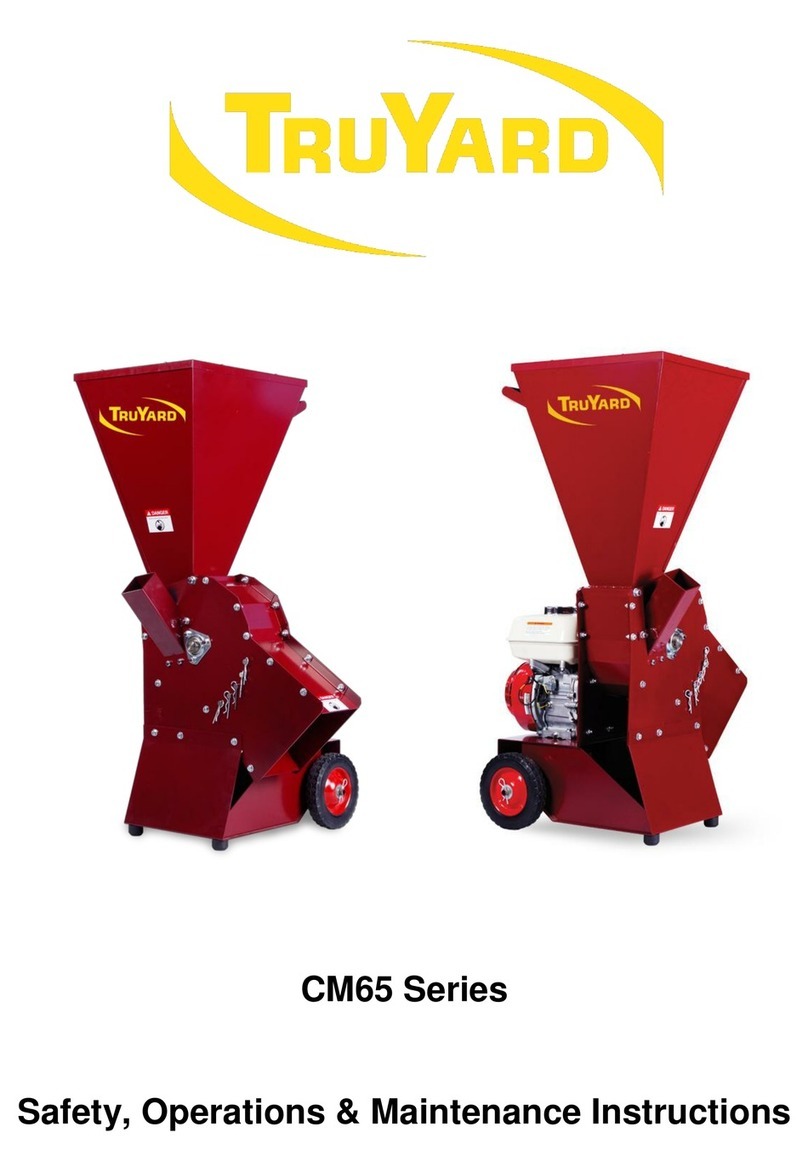
TruYard
TruYard CM65 Series Safety, operation & maintenance instructions
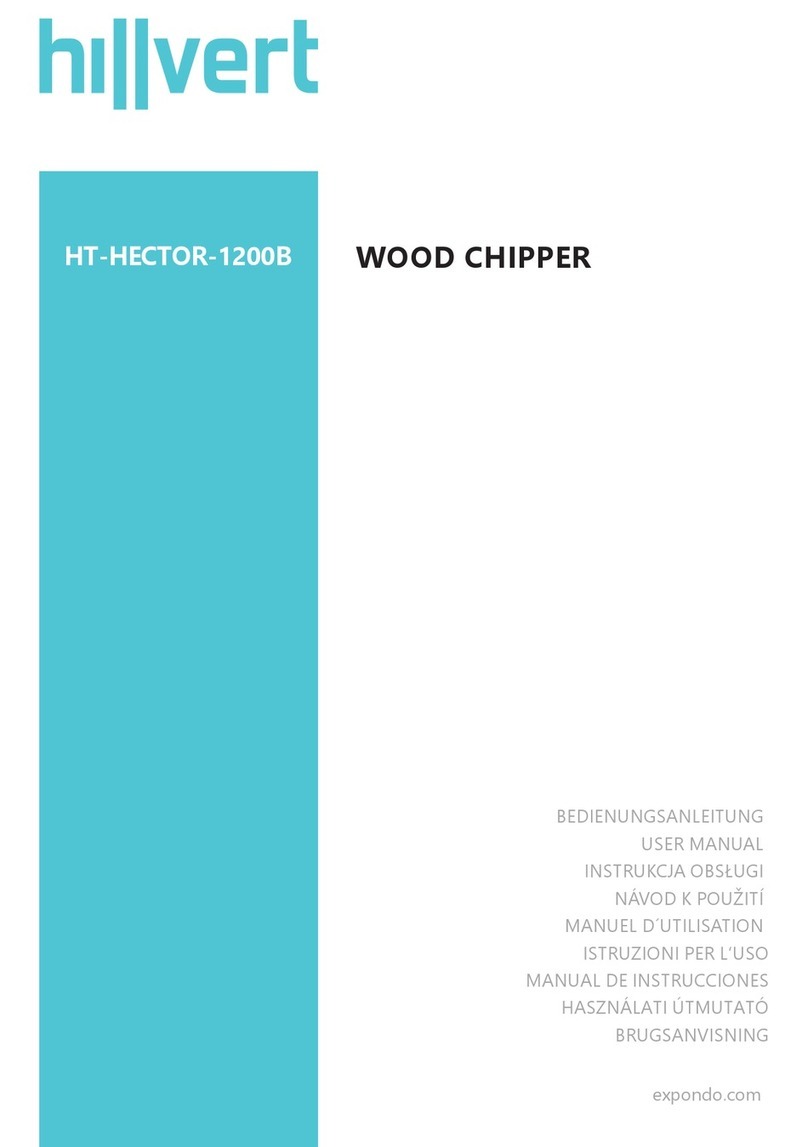
hillvert
hillvert HT-HECTOR-1200B user manual
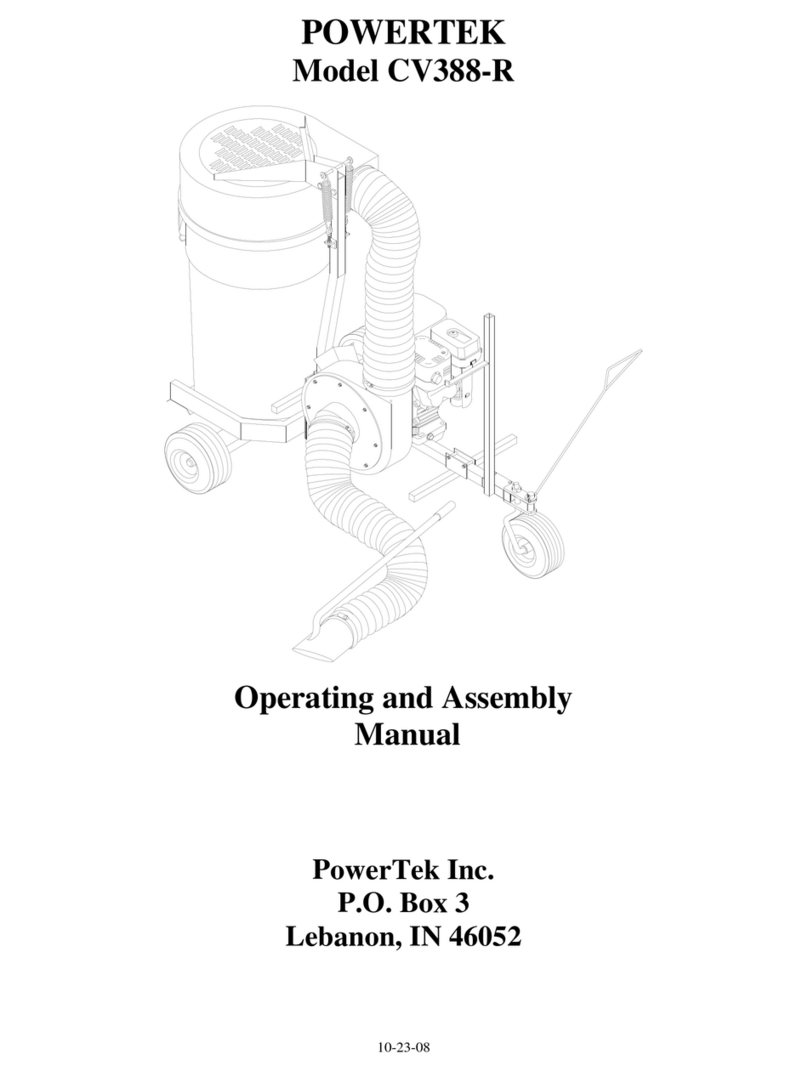
PowerTek
PowerTek CV388-R Assembly manual
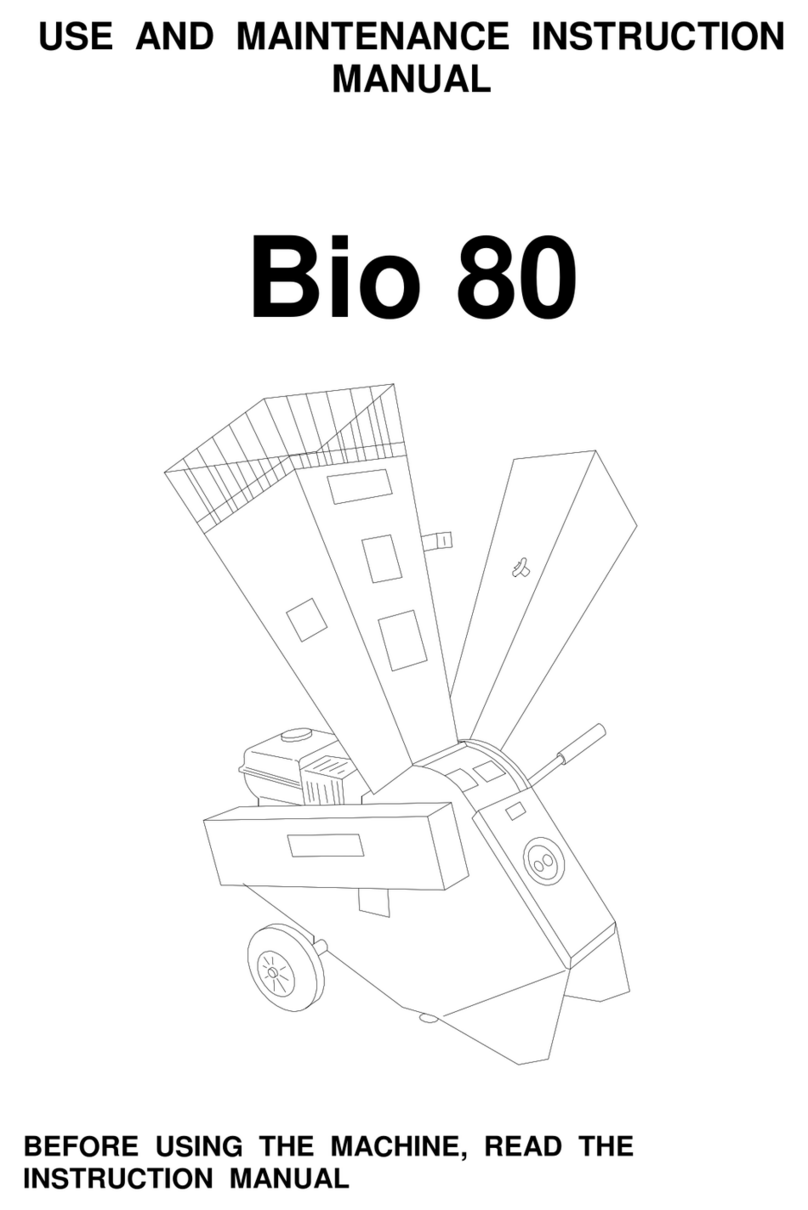
Caravaggi
Caravaggi Bio 80 Use and maintenance instruction manual

Carlton
Carlton 2015 owner's manual
